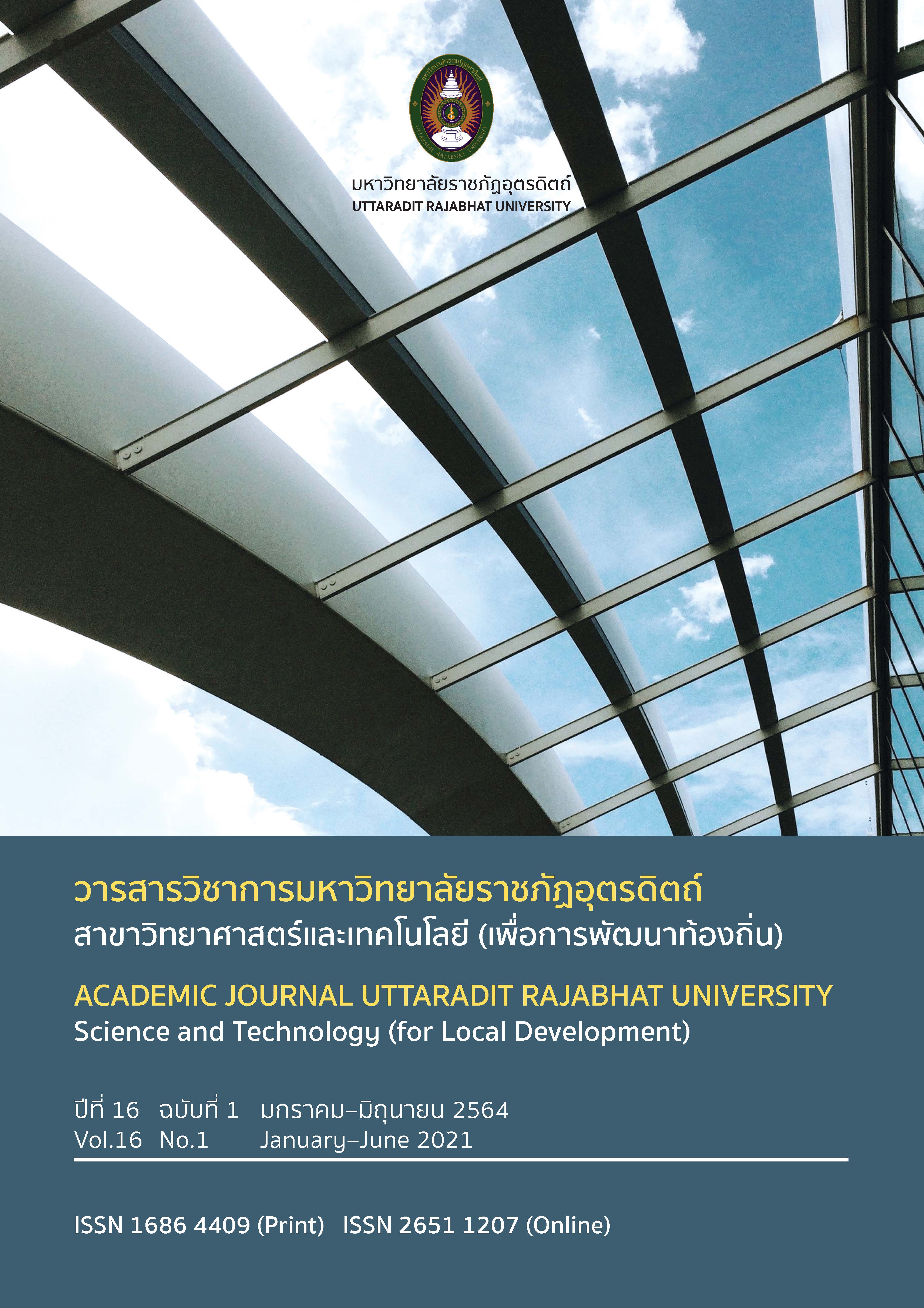การผลิตไบโอดีเซลจากน้ำมันพืชใช้แล้วในชุมชนจังหวัดเชียงใหม่ โดยตัวเร่งปฏิกิริยาเปลือกปูม้า
Main Article Content
บทคัดย่อ
การผลิตไบโอดีเซลจากน้ำมันพืชใช้แล้วในชุมชน ด้วยปฏิกิริยาทรานส์เอสเทอริฟิเคชัน โดยใช้ตัวเร่งปฏิกิริยาวิวิธพันธุ์จากธรรมชาติได้รับความสนใจเป็นอย่างมาก เนื่องจากเป็นมิตรต่อสิ่งแวดล้อมและช่วยลดต้นทุนการผลิตในชุมชน โดยงานวิจัยนี้จึงมีวัตถุประสงค์เพื่อศึกษาการผลิตไบโอดีเซลจากน้ำมันพืชใช้แล้วในชุมชน โดยใช้ตัวเร่งปฏิกิริยาจากเปลือกปูม้าเหลือทิ้งจากการแกะเนื้อปูม้าในชุมชนชาวประมง โดยทำการเผาที่อุณหภูมิ 900 oC เป็นเวลา 4 hr ทำการทดลองที่อัตราส่วนโดยโมลของเมทานอลต่อน้ำมัน 3:1-15:1 ปริมาณตัวเร่งปฏิกิริยาที่ 5-15%wt และเวลาในการทำปฏิกิริยา 2 hr เมื่อวิเคราะห์ตัวเร่งปฏิกิริยาเปลือกปูม้า โดยการวิเคราะห์ลักษณะสัณฐานในระดับจุลภาค ด้วยกล้องจุลทรรศน์อิเล็กตรอนแบบส่องกราด (SEM) และวิเคราะห์องค์ประกอบด้วยเทคนิค XRF พบว่า มีการกระจายตัวของอนุภาคอย่างต่อเนื่องและมีรูพรุนในโครงสร้างของอนุภาคซึ่งทำให้มีพื้นที่ผิวสัมผัสสูง โดยมีค่าพื้นที่อนุภาคเฉลี่ย พื้นที่รูพรุนเฉลี่ยและเส้นผ่านศูนย์กลางรูพรุนเฉลี่ยอยู่ที่ 463.97 µm2, 1.25 µm2 และ 1.34 µm ตามลำดับ การวิเคราะห์ธาตุและสารประกอบของตัวเร่งปฏิกิริยาเปลือกปูม้า พบว่ามีแคลเซียม (Ca) และแคลเซียมออกไซด์ (CaO) สูง อยู่ที่ประมาณ 48.34% และ 75.21% ตามลำดับ โดยสัดส่วนการผลิตไบโอดีเซลที่เหมาะสม คือ ปริมาณตัวเร่งปฏิกิริยา 10% ที่อัตราส่วนโดยโมลของเมทานอลต่อน้ำมัน 9:1 ที่ 65 oC เป็นเวลา 2 hr ผลผลิตไบโอดีเซลสูงสุดที่ 82.58% ไบโอดีเซลที่ผลิตได้สามารถประยุกต์ใช้ได้ในชุมชน และมีสมบัติใกล้เคียงกับมาตรฐานของกรมธุรกิจพลังงาน (ประเทศไทย)
Downloads
Article Details
เอกสารอ้างอิง
2. จิรพัฒน์พงษ์ เสนาบุตร, อมรรัตน์ ปิ่นชัยมูล, และ กนกพงษ์ ศรีเที่ยง. (2560). การปรับปรุงคุณภาพน้ำมันที่ได้จากการไพโรไลซิสพลาสติกพอลิพรอพิลีนเป็นเชื้อเพลิงโดยใช้ตัวเร่งปฏิกิริยาซิลิกาอสัณฐานที่ทำการสกัดได้จากแกลบข้าว. วารสารวิชาการคณะเทคโนโลยีอุตสาหกรรม มหาวิทยาลัยราชภัฏลำปาง ปีที่ 10 ฉบับที่ 2 กรกฎาคม 2560 – ธันวาคม 2560, 12-23.
3. เพ็ญจิตร ศรีนพคุณ. (2561). กลยุทธ์การผลิตไบโอดีเซลเชิงพาณิชย์. กรุงเทพฯ: สำนักพิมพ์แห่งมหาวิทยาลัยเกษตรศาสตร์.
4. ศรีสุดา อาชวานันทกุล. (2560). การบัญชีต้นทุน. กรุงเทพฯ: สำนักพิมพ์แห่งมหาวิทยาลัยธรรมศาสตร์.
5. รัชฎาภรณ์ อินเกิด, ชูรัตน์ ธารารักษ์, จุฑาภรณ์ ชนะถาวร, และ ณัฐวุฒิ ดุษฎี. (2559). การสังเคราะห์น้ำมันหล่อลื่นชีวภาพจากน้ำมันพืชด้วยกระบวนการทรานส์เอสเทอร์ริฟิเคชัน. การประชุมวิชาการเครือข่ายพลังงานแห่งประเทศไทยครั้งที่ 12, 754-760.
6. วรวุฒิ จุฬาลักษณานุกูล. (2559). เชื้อเพลิงชีวภาพด้วยตัวเร่งชีวภาพ. กรุงเทพฯ: สำนักพิมพ์แห่งจุฬาลงกรณ์มหาวิทยาลัย.
7. Hazri, M. M., and Nasir, N. F. (2020). Calcium Oxide from Waste Shells as Potential Green Catalyst for Biodiesel Production. Research progress in mechanical and manufacturing engineering 1(1), 44-55.
8. Jeffry, S. N. A., Putra Jaya, R., Abdul Hassan, N., Yaacob, H., Mahmud, M. Z. H., and Al-Saffar, Z. H. (2020). The influence of nano-carbon from coconut shell ash as modifier on the properties of bitumen. Road Materials and Pavement Design, 1–17.
9. Laskar, I. B., Rajkumari, K., Gupta, R., Chatterjee, S., Paul, B., and Rokhum, L. (2018). Waste snail shell derived heterogeneous catalyst for biodiesel production by the transesterification of soybean oil. RSC Advances, 8(36), 20131–20142.
10. Li, C., Hu, X., Feng, W., Wu, B., and Wu, K. (2017). A supported solid base catalyst synthesized from green biomass ash for biodiesel production. Energy Sources, Part A: Recovery, Utilization, and Environmental Effects, 40(2), 142–147.
11. Mansir, N., Taufiq-Yap, Y. H., Rashid, U., and Lokman, I. M. (2017). Investigation of heterogeneous solid acid catalyst performance on low grade feedstocks for biodiesel production: A review. Energy Conversion and Management, 141, 171–182.
12. Panpraneecharoen, S., Chumanee, S., Pongpian, W., Khoomsab, R., and Rodkate, N. (2018). Study the optimal conditions for biodiesel production from used cooking oil with potassium hydroxide catalyst. Journal of Science & Technology Phetchabun Rajabhat University (JSTPCRU), 3(1), 1-12.
13. Raya, I., Mayasari, E., Yahya, A., Syahrul, M., and Latunra, A. I. (2015). Shynthesis and Characterizations of Calcium Hydroxyapatite Derived from Crabs Shells (Portunus pelagicus) and Its Potency in Safeguard against to Dental Demineralizations. International Journal of Biomaterials, 1–8.
14. Sirisomboonchai, S., Abuduwayiti, M., Guan, G., Samart, C., Abliz, S., Hao, X., Kusakabe, K., and Abudula, A. (2015). Biodiesel production from waste cooking oil using calcined scallop shell as catalyst. Energy Conversion and Management, 95, 242–247.
15. Sivakumar, P., Sivakumar, P., Anbarasu, K., Mathiarasi, R., and Renganathan, S. (2014). An eco-friendly catalyst derived from waste shell of Scylla tranquebaricafor biodiesel production. International Journal of Green Energy, 11(8), 886–897.
16. Zhang, J., Lu, M., Ren, F., Knothe, G., and Tu, Q. (2019). A Greener Alternative Titration Method for Measuring Acid Values of Fats, Oils, and Grease. Journal of the American Oil Chemists’ Society.


